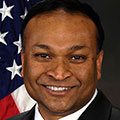Historians sometimes speak of the Axial Age, referring to an ancient era that saw the coincident appearance of major religious and philosophical movements in widely scattered regions of the world. It represented a turning point in the course of human affairs.
This first decade of the 21st century may prove to be the Axial Age of the Global Navigation Satellite System (GNSS) community. Consider these signs and portents:
The U.S. Global Positioning System is poised to regain its momentum and sense of direction.
Historians sometimes speak of the Axial Age, referring to an ancient era that saw the coincident appearance of major religious and philosophical movements in widely scattered regions of the world. It represented a turning point in the course of human affairs.
This first decade of the 21st century may prove to be the Axial Age of the Global Navigation Satellite System (GNSS) community. Consider these signs and portents:
The U.S. Global Positioning System is poised to regain its momentum and sense of direction.
Russia’s GLONASS system is showing a sustained and growing resurgence.
And Europe has launched GIOVE A, the first prototype spacecraft for a 30-satellite constellation scheduled to come on-line over the next few years.
Regional augmentation systems adding accuracy and navigation signals to the basic GNSSes are being built by the United States, Europe, India, and Japan. And we may still not have seen the last of the full-fledged GNSSes, if reports of China’s continuing interest in building its own system prove true.
Until now, positioning has been a lot like the weather: everybody talked about it, but nobody did anything about it. They couldn’t — not practically, not without affordable, accessible tools and the techno-cultural sensibilities to bring it about. It was as though we were talking about time before the advent of the pocket watch.
Part of this situation arises from the human psyche itself: we usually have this innate and immediate sense of where we are and where we’re going. We may even think we know where the kids are. So, why would we ever need a positioning device, whatever that is?
And yet, these are highly subjective and relative sensibilities. It’s the locational equivalent of telling time by looking at the sun or trying to recall whether the last round of cathedral bells called out Matins or Lauds.
Of course, despite appearances, all time is relative (or perhaps not), if only in relationship to the excitations of a cesium atom. So, too, is location, which depends on a map datum to sort out the places from the spaces, or positioning, which uses mathematical strategems to make sense of the folly of the geoid. And those constructs have beginning points and terms of reference that are thoroughly conventional, not divine.
Slowly, steadily, but with an ever-growing momentum, GNSS-driven applications of accurate time and location are entering the popular imagination. Today, hundreds of millions of people are walking around with GPS receivers in their pockets — whether they know it or not. And literally billions are benefiting from the myriad uses to which the technology is being put.
Yes, the portals may be swinging open to a land of milk and honey for GNSS manufacturers, engineers, and users. And, then again, maybe the doors will swing shut again.
All three systems have reached a kind of unsteady equilibrium, a balance of the forces driving them ahead and those that would slow them down or drive them aside from their charted courses. The way ahead is neither predestined nor foretold. It will depend upon the energy, attention, skills, and motives of many people around the world.
Nonetheless, having spent the past 16 years chronicling the adventures of the GNSS community, I enter this era with more hope and expectation than ever about the prospects for this amazing utility. I believe that we are at a historic turning point in technology.
This magazine, then, will serve as a vehicle for carrying the continuing story of this community into a new phase, a new age of GNSS.





